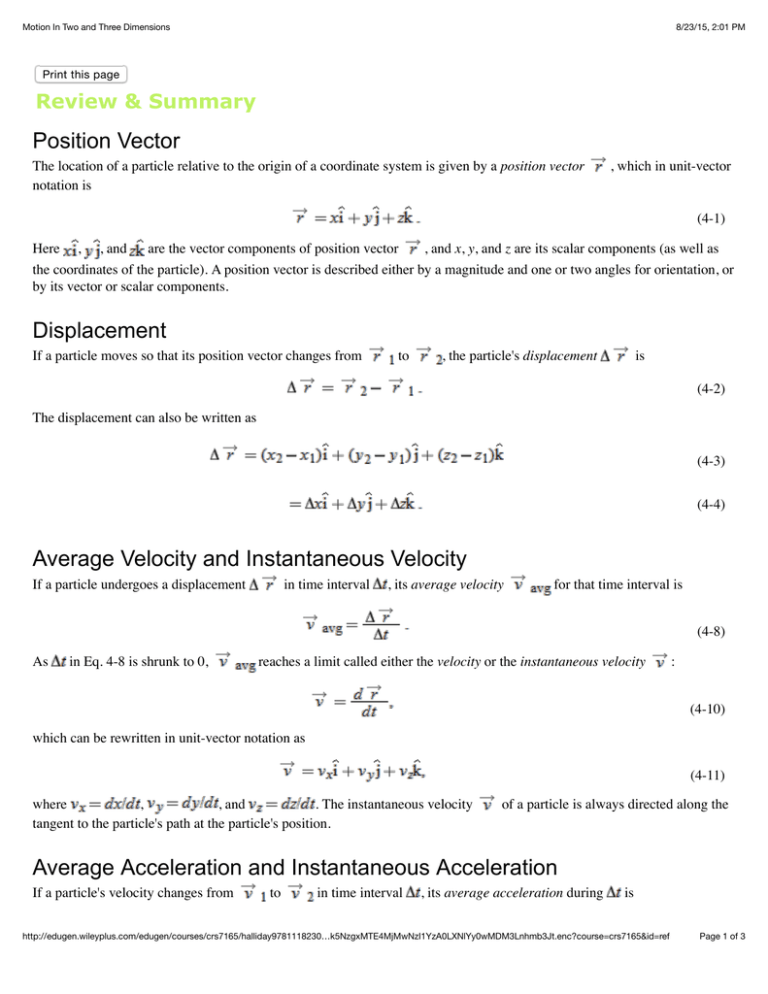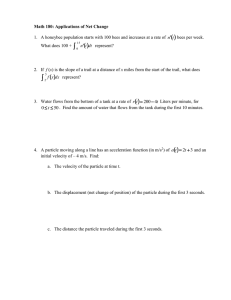
Motion In Two and Three Dimensions
8/23/15, 2:01 PM
Print this page
Review & Summary
Position Vector
The location of a particle relative to the origin of a coordinate system is given by a position vector
notation is
, which in unit-vector
(4-1)
Here , , and
are the vector components of position vector
, and x, y, and z are its scalar components (as well as
the coordinates of the particle). A position vector is described either by a magnitude and one or two angles for orientation, or
by its vector or scalar components.
Displacement
If a particle moves so that its position vector changes from
to
, the particle's displacement
is
(4-2)
The displacement can also be written as
(4-3)
(4-4)
Average Velocity and Instantaneous Velocity
If a particle undergoes a displacement
in time interval
, its average velocity
for that time interval is
(4-8)
As
in Eq. 4-8 is shrunk to 0,
reaches a limit called either the velocity or the instantaneous velocity
:
(4-10)
which can be rewritten in unit-vector notation as
(4-11)
where
,
, and
. The instantaneous velocity
tangent to the particle's path at the particle's position.
of a particle is always directed along the
Average Acceleration and Instantaneous Acceleration
If a particle's velocity changes from
to
in time interval
, its average acceleration during
is
http://edugen.wileyplus.com/edugen/courses/crs7165/halliday9781118230…k5NzgxMTE4MjMwNzI1YzA0LXNlYy0wMDM3Lnhmb3Jt.enc?course=crs7165&id=ref
Page 1 of 3
Motion In Two and Three Dimensions
8/23/15, 2:01 PM
(4-15)
As
in Eq. 4-15 is shrunk to 0,
acceleration
:
reaches a limiting value called either the acceleration or the instantaneous
(4-16)
In unit-vector notation,
(4-17)
where
,
, and
.
Projectile Motion
Projectile motion is the motion of a particle that is launched with an initial velocity
. During its flight, the particle's
horizontal acceleration is zero and its vertical acceleration is the free-fall acceleration
(Upward is taken to be a positive
direction.) If
is expressed as a magnitude (the speed v0) and an angle θ0 (measured from the horizontal), the particle's
equations of motion along the horizontal x axis and vertical y axis are
(4-21)
(4-22)
(4-23)
(4-24)
The trajectory (path) of a particle in projectile motion is parabolic and is given by
(4-25)
if x0 and y0 of Eqs. 4-21 to 4-24 are zero. The particle's horizontal range R, which is the horizontal distance from the
launch point to the point at which the particle returns to the launch height, is
(4-26)
Uniform Circular Motion
If a particle travels along a circle or circular arc of radius r at constant speed v, it is said to be in uniform circular motion and
has an acceleration
of constant magnitude
http://edugen.wileyplus.com/edugen/courses/crs7165/halliday9781118230…k5NzgxMTE4MjMwNzI1YzA0LXNlYy0wMDM3Lnhmb3Jt.enc?course=crs7165&id=ref
Page 2 of 3
Motion In Two and Three Dimensions
8/23/15, 2:01 PM
(4-34)
The direction of
is toward the center of the circle or circular arc, and
particle to complete a circle is
is said to be centripetal. The time for the
(4-35)
T is called the period of revolution, or simply the period, of the motion.
Relative Motion
When two frames of reference A and B are moving relative to each other at constant velocity, the velocity of a particle P as
measured by an observer in frame A usually differs from that measured from frame B. The two measured velocities are
related by
(4-44)
where
is the velocity of B with respect to A. Both observers measure the same acceleration for the particle:
(4-45)
Copyright © 2014 John Wiley & Sons, Inc. All rights reserved.
http://edugen.wileyplus.com/edugen/courses/crs7165/halliday9781118230…k5NzgxMTE4MjMwNzI1YzA0LXNlYy0wMDM3Lnhmb3Jt.enc?course=crs7165&id=ref
Page 3 of 3






